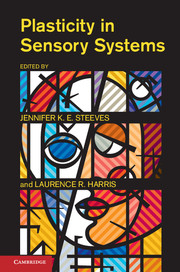Book contents
- Frontmatter
- Contents
- List of Contributors
- 1 Plasticity in Sensory Systems
- I VISUAL AND VISUOMOTOR PLASTICITY
- 2 The Distributed Nature of Visual Object Learning
- 3 Motor Adaptation and Proprioceptive Recalibration
- 4 Deficits and Adaptation of Eye-Hand Coordination During Visually Guided Reaching Movements in People with Amblyopia
- II PLASTICITY IN CHILDHOOD
- III PLASTICITY IN ADULTHOOD AND VISION REHABILITATION
- Author Index
- Subject Index
- References
2 - The Distributed Nature of Visual Object Learning
from I - VISUAL AND VISUOMOTOR PLASTICITY
Published online by Cambridge University Press: 05 January 2013
- Frontmatter
- Contents
- List of Contributors
- 1 Plasticity in Sensory Systems
- I VISUAL AND VISUOMOTOR PLASTICITY
- 2 The Distributed Nature of Visual Object Learning
- 3 Motor Adaptation and Proprioceptive Recalibration
- 4 Deficits and Adaptation of Eye-Hand Coordination During Visually Guided Reaching Movements in People with Amblyopia
- II PLASTICITY IN CHILDHOOD
- III PLASTICITY IN ADULTHOOD AND VISION REHABILITATION
- Author Index
- Subject Index
- References
Summary
Introduction
We mostly take object vision for granted, simply because our brain makes it seem easy. As a consequence, most of what we learn about objects during both development and adulthood goes unnoticed. Once the input to the system is in order (so excluding retinal disorders), almost all people can recognize cars, Coca-Cola bottles, and Barbie dolls. We only get a glimpse of the complexity of the underlying processes when we go through the most challenging tasks that we are typically confronted with. For example, some people have below average skills in face recognition. In this respect, interindividual differences in the most challenging object recognition tasks, created either naturally or in the lab by manipulating experience, serve as a gold mine for trying to understand the brain's exceptional ability to recognize objects.
My favorite example of an idiosyncratic object recognition talent is Gudrun, my eight-year-old daughter. She has a favorite teddy bear, are affection that developed when she was only a few months old. When Gudrun was one year old, my wife and I bought a second identical bear (just in case the first one was lost). Obviously, she noticed the difference between the old bear (which she calls “pretty bear”) and the new one. It was also easy for us parents to differentiate between the old worn bear and the new exemplar. However, over the years these differences became very minor, and now no one can reliably differentiate “pretty bear” from “new bear.”
Information
- Type
- Chapter
- Information
- Plasticity in Sensory Systems , pp. 9 - 32Publisher: Cambridge University PressPrint publication year: 2012
References
Accessibility standard: Unknown
Why this information is here
This section outlines the accessibility features of this content - including support for screen readers, full keyboard navigation and high-contrast display options. This may not be relevant for you.Accessibility Information
- 1
- Cited by
